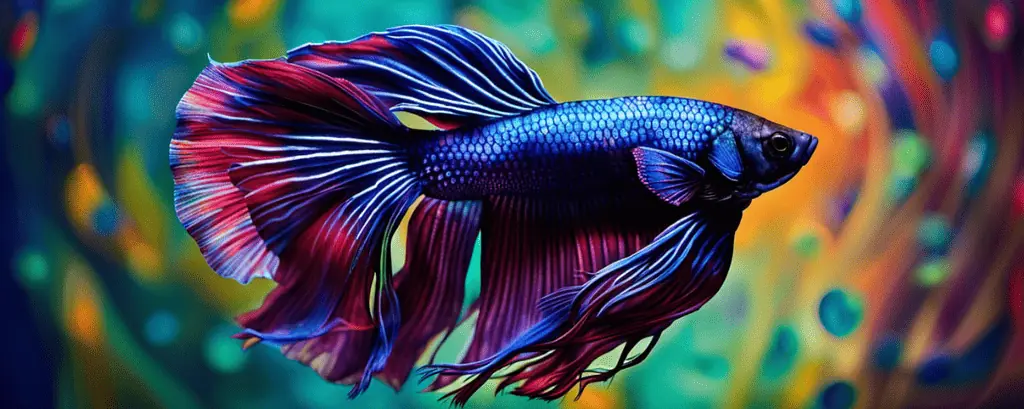Bettas are one of the most popular fish species in freshwater aquariums.
With their bright colors and flowy fins, it’s easy to see why!
But there’s so much more to these fish than their beautiful appearance.
Whether you’re a new or experienced betta fish owner, keep reading for some fun facts you probably didn’t know about this amazing fish!

Top 29 Betta Fish Fun Facts
1. Bettas Are Also Called “Siamese Fighting Fish”
According to records, bettas were bred for fighting in Thailand (formerly Siam) as early as the 1800s.
Children would gather the fish from rice paddies and host fights, where the winner became the “village champion.”
The King of Siam even sanctioned betta fights, which is how they became known as “Siamese fighting fish.”
Betta fish fighting is still allowed in certain parts of the world.
2. Bettas Can Breathe Air
Adult bettas can breathe fresh air above the water’s surface through their labyrinth organ.
But they are not born with this special organ.
A betta fry takes in oxygen from the water through its gills. The betta’s labyrinth organ is not fully developed until the fish is 3-6 weeks old.
3. Bettas Can Live Up to 5 Years
Betta fish have an average lifespan ranging from 2-4 years.
But with proper care, bettas can live up to 5 years or more.
The oldest betta fish on record was 10 years old!
4. Male Bettas Build Bubble Nests
Male bettas build bubble nests on the surface in preparation for their offspring.
When the female betta fish releases her eggs, the male carries them in his mouth and places them in the protective bubble nest.
The male betta then protects the nest and raises the babies until they can swim free on their own.
5. Betta Fish Are Smart
Bettas are a very intelligent fish species.
They can recognize their owners and learn when it’s feeding time.
These fish needs lots of enrichment activities and stimulation, or else they get bored.
6. Bettas Come in a Wide Variety of Colors and Patterns

Domestic betta fish come in an almost endless array of vivid colors and unique patterns. Wild-type bettas have dull colors, which camouflages them from predators and prey.
Common domestic betta colors include:
- Red
- Blue
- Yellow
- Turquoise
- Black
- White
These fish may have solid colors or a mixture of different patterns, such as:
- Butterfly
- Koi
- Black Orchid
- Dalmation
- Chocolate
- Dragonscale
Due to selective breeding, new color combinations appear every year. Bettas with the marble gene can even change colors several times during their lives!
Learn more about the betta’s unique colors by visiting the link.
7. Betta Fish Are Carnivores
Bettas are carnivores, so they need lots of animal protein in their diet.
In addition to high-protein betta pellets, add some variety to your betta’s diet with live foods.
Some favorite snacks for bettas include brine shrimp, mosquito larvae, and bloodworms.
8. Bettas Can Survive in Stagnant Waters
Wild bettas live in shallow bodies of water, such as rice paddies and small ponds.
Their labyrinth organ helps them survive in oxygen-starved environments.
This organ lets the betta breathe fresh air until it can find an oxygen-rich body of water.
9. Bettas Are Native to Southeast Asia
Bettas were originally discovered in the Mekong Basin near Thailand.
They are also found throughout other parts of Southeast Asia, such as:
- Vietnam
- Laos
- Cambodia
- Malaysia
- Parts of China
Due to the destruction of their natural habitats, wild bettas are classified as endangered in many areas of Southeast Asia.
10. Bettas Have Been Selectively Bred for Over 1,000 Years

New studies confirm betta fish have been selectively bred in captivity for at least 1,000 years.
This makes bettas one of the oldest domesticated species of fish in the world.
Domestic betta fish species look much different than wild-type bettas because of selective breeding for different colors and tail types.
11. Bettas Are Named After Warriors
Bettas originally got their name from the Malay word “ikan betah,” which means “persistent fish.”
When the King of Siam gave some of his prized fish to scientist Dr. Theodor Cantor, he called the species “Macropodus Pugnax.”
In 1909, Tate Regan discovered there was already a fish species with this name. He later renamed the fish “Betta splendens.”
“Betta” was inspired by the ancient warriors of the Bettah tribe. “Splendens” refers to the fish’s splendid fins and appearance.
12. Bettas Have Poor Vision
Bettas can distinguish colors on the blue and green spectrums better than humans.
But they have very poor depth perception and cannot see much in the dark.
These fish rely on their hearing and senses of smell and taste to find food and detect predators.
13. Female Bettas Are Less Colorful Than Males
In the betta fish color lottery, the males are the clear winners.
Male bettas have brighter colors and longer fins than females.
Female betta fish are still colorful but much less so than males. They also have shorter fins and tails.
14. Betta Fish Can Do Tricks
With some training and a little patience, your betta can learn a variety of tricks.
These little fish can do things like jump through hoops and follow your finger through an obstacle course!
Bettas are very food motivated, so a couple of treats help the training process.
15. Bettas Help with Pest Control
Wild betta fish are efficient in pest control.
These carnivores catch mosquitoes and other insects near the water’s surface.
They also feed on insect larvae, controlling the bug population.
16. Wild Bettas Live in Shallow Waters
Wild bettas live in shallow, slow-moving waters throughout Southeast Asia.
Their native habitats include:
- Rice paddies
- Forest marshes
- Slow-moving streams
- Stagnant ponds
But this doesn’t mean captive bettas should live in small vases or fish bowls. Bettas need ample space for swimming and exploring their habitat.
The smallest recommended tank size for a betta is 5 gallons.
Your fish also needs a filter and heater.
A filter helps oxygenate the tank water and remove harmful bacteria. An aquarium heater maintains stable warm water temperatures for these tropical fish.
17. Bettas Have a Unique Organ Called the Operculum
Bettas are one of the few fish species with a unique organ called the operculum.
The operculum acts as a shield, protecting the betta’s fragile gills. They also have a small beard near the operculum.
In male bettas, the operculum protrudes a bit.
Bettas use the operculum for flaring and lengthening their beard. This makes the fish look larger and scares away potential predators.
18. Bettas Can Change Color

A betta’s color can change according to its health.
Sick or stressed bettas have a pale color. A healthy betta’s colors are more vivid.
It is not uncommon for bettas to change color after bringing them home from the pet store. This usually happens because their new home is a much healthier environment.
19. Bettas Are Symbols of Good Luck and Prosperity
In Thailand, betta fish are symbols of good luck and prosperity. Bettas are also believed to ward off evil spirits.
Betta fish have symbolism in other cultures, as well.
Native Americans see the betta fish as a symbol of strength, courage, and determination.
Celtic cultures view bettas as symbols of transformation and new beginnings.
In many African cultures, betta fish symbolize fertility.
20. There Are Over 70 Species of Betta Fish
To date, there are 75 different recognized species of betta fish.
The most popular species is Betta splendens.
Other types of betta fish kept as pets include wild-type bettas, such as:
- Betta mahachaiensis
- Betta smaragdina
- Betta imbellis
- Betta macrostoma
21. Betta Fish Can Jump
Betta fish can jump up to 3″ inches high!
They use this ability to seek better water conditions in the wild.
This is why having a lid on your betta tank is so important. A lid keeps your betta in the aquarium instead of on the floor.
22. Betta Fish Like To Nap

Some bettas are more active than others. But there is one thing all bettas have in common: they enjoy their downtime.
Bettas sleep at night when it is dark, but they also enjoy quick naps throughout the day.
You may see your betta resting on plant leaves, inside of decor, or even on the substrate in the daytime.
23. The Betta Fish is Thailand’s National Marine Animal
In 2013, the Cultural Ministry named the betta fish the national aquatic animal of Thailand.
Thailand hopes this designation can boost the conservation and commercial breeding efforts of the betta.
Betta fish are currently on the endangered species list in Southeast Asia due to the destruction of their natural habitats.
24. Bettas Can Survive for Up To 2 Weeks Without Food
Betta fish can survive for up to 14 days without food.
During this time, the betta’s metabolism slows down and they conserve energy.
While they can survive without food, it puts a lot of stress on the fish. Never leave your betta without food for more than 3 days.
25. Bettas Have Teeth
Betta fish have very tiny teeth they use for biting and crushing up their food.
They also use their teeth for ripping up fins when another fish invades their territory.
Your betta may bite you, but its teeth are so small you likely won’t feel it.
26. Bettas Can Regrow Their Fins
When bettas suffer from torn fins or mild cases of fin rot, they can regrow their fins.
The fins may look different than before, especially if the damage is severe.
It can take several weeks before the fins regrow after getting damaged.
27. Bettas Have a Swim Bladder
Betta fish have a buoyancy organ called the swim bladder.
The swim bladder contains oxygen gas and helps the betta maintain its desired depth in the water.
When the swim bladder gets inflamed, your betta may have trouble staying upright or swimming to the surface.
28. Bettas Have Upturned Mouths
Besides giving them a grumpy appearance, a betta’s upturned mouth serves a purpose.
A betta’s upturned mouth helps them catch insects on the water’s surface. It also makes gulping fresh air easy for them.
29. A Betta’s Stomach Is the Same Size As Its Eyes
Bettas are greedy eaters, but there’s not much room for a lot of food.
A betta’s stomach is about the same size as its eyeballs.
When a betta overeats, its stomach fills up fast. This leads to issues like bloating and constipation.
A swollen stomach also puts pressure on the swim bladder. In some cases, this can lead to swim bladder disease.
Getting To Know Your Betta
It’s no wonder why betta fish are such popular aquatic pets.
These colorful fish are very intelligent and have quirky personalities.
Bettas can learn tricks, jump in the air, and even recognize their owners.
I hope this list helped you learn some new things about your betta buddy.
Learn more about caring for these amazing fish with our helpful guide at the link.


